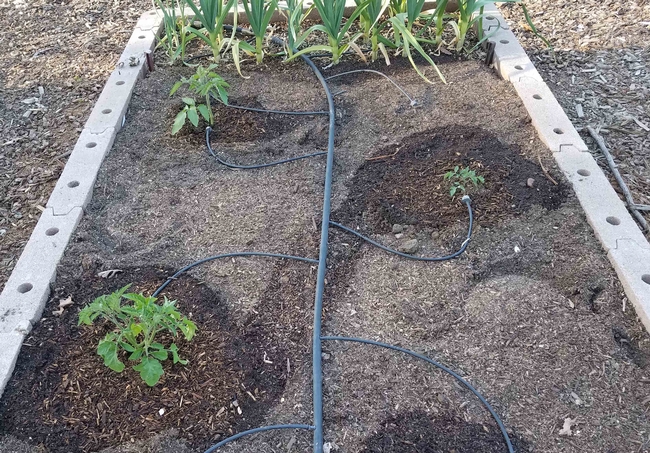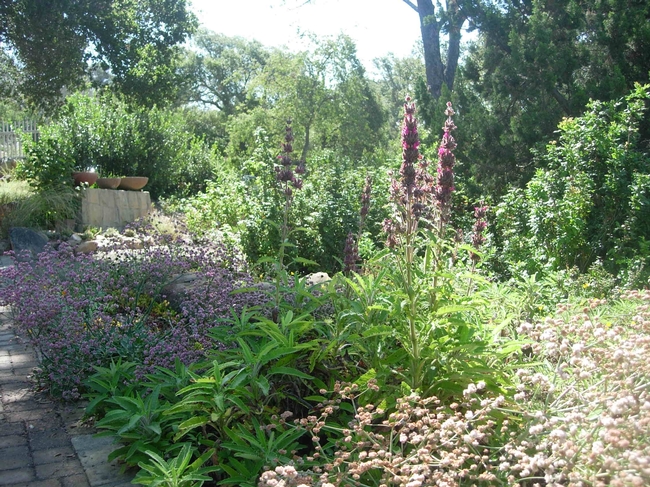- (Focus Area) Yard & Garden
Are your tomatoes not looking their beautiful best this year? They may be suffering from blossom end rot.
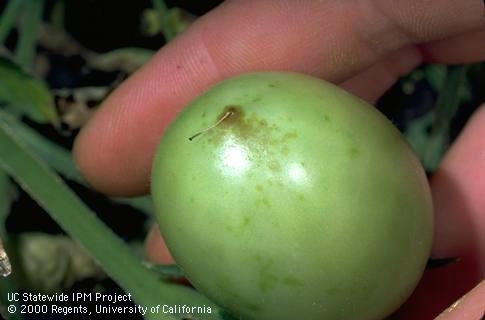
End rot is not caused by a disease or a pest. It is a physiological problem caused by a low level of calcium in the tomato fruit. This calcium deficiency is usually caused by irregular watering. Water carries calcium and other nutrients throughout the plant, and without enough water, the calcium, which is being used first for foliar growth, doesn't make its way to the fruits.
Calcium is required in relatively large concentrations for normal cell growth, and when the rapidly-growing fruit is deprived of calcium the tissues break down, leaving the characteristic lesion.
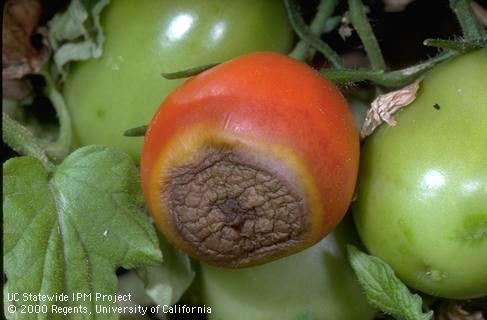
Other factors that can reduce the uptake and movement of calcium into the plant include low calcium levels in the soil, excessive soil moisture, root damage, and a soil pH that is too high or too low below the optimum 6.5.
To control this problem, maintain even soil moisture by watering regularly. Amending the soil with organic matter such as compost will improve the soil's ability to retain water, and mulching around your tomatoes will reduce water evaporation from the soil.
Avoid heavy applications of high-nitrogen fertilizer, and if your soil is deficient in calcium, it can be amended with gypsum or another source of calcium. One easily available source of calcium happens to be eggshells, which are high in calcium carbonate, an excellent soil amendment. Incorporating crushed eggshells into the soil around tomato plants or at the bottom of their planting holes will help prevent blossom end rot.
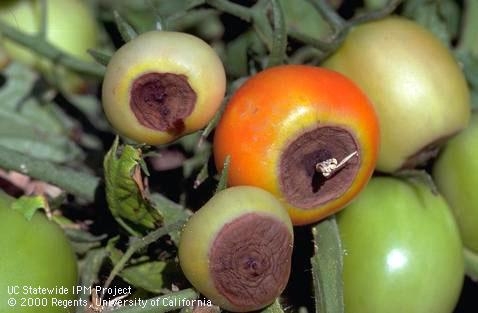
UC Master Gardeners of Butte County are part of the University of California Cooperative Extension (UCCE) system. To learn more about us and our upcoming events, and for help with gardening in our area visit our website. If you have a gardening question or problem, email the Hotline at mgbutte@ucanr.edu or leave a phone message on our Hotline at 530-552-5812. To speak to a Master Gardener about a gardening issue, or to drop by the MG office during Hotline hours, see the most current information on our Ask Us section of our website.
- Author: Barbra Braaten
Water is essential for any garden, but it's crucial to use water wisely in a place like California, where droughts are common. Effective water management can help home gardeners keep their plants healthy while conserving this precious resource. Thoughtful water management uses resources efficiently and sustainably to meet current and future needs. It involves planning, developing, distributing, and managing the optimum use of water to ensure plants survive and look good. By conserving water, home gardeners contribute to the preservation of local ecosystems and the sustainability of the environment.
Plant Water Use
Understanding how much water your plants need is the first step in effective water management. Different plants have different water requirements. For instance, succulents and cacti need less water than vegetables or fruit trees. It's important to group plants with similar water needs together. This way, you can avoid overwatering or underwatering specific plants. You can learn about plant water needs from plant labels, gardening books, or by reaching out to your local UC Master Gardener volunteers for support. Additionally, observing your plants and learning their symptoms of water stress, such as wilting or drooping leaves, can also help inform water management.
Watering Systems
Several watering systems can help manage water use in a garden. Drip irrigation is one of the most efficient methods. It delivers water directly to the roots of plants, minimizing evaporation and runoff. Soaker hoses, porous hoses that seep water along their length, are another good option for watering garden beds. Traditional sprinklers can be used, but they are less efficient because they tend to waste water through evaporation and runoff. Newer, more advanced systems include weather-based controllers that adjust watering schedules based on weather conditions, ensuring plants get the right amount of water without waste.
Irrigation Best Practices
Take a proactive role in water conservation by adopting best practices for irrigation. Watering early in the morning or late in the evening reduces evaporation, ensuring more water reaches the plants. Mulching the garden helps retain soil moisture and reduces the need for frequent watering. Regularly checking for leaks in the irrigation system and repairing them promptly can prevent water loss. Adjusting the watering schedule based on the season and weather conditions is also essential. During cooler months or after rainfall, plants need less water; in the hot summer, they may need more frequent watering.
Use Drought Tolerant Plants
One of the most environmentally responsible ways to conserve water in a garden is to use drought-tolerant and/or native plants. Drought tolerance reflects the ability of a plant to withstand less than optimal water supplies due to adaptive or avoidance mechanisms. While many native plants possess drought-tolerant traits and require less supplemental irrigation once established, many non-native plants Mediterranean-adapted plants also thrive on relatively lower water. It is important to remember that these plants require water regularly until their root structure is well established in landscape soil. Maintaining these plants with deep and infrequent irrigation once established is a great way to reduce landscape water use. By incorporating these plants into your garden, you're also providing habitat for local wildlife. This creates a beautiful, low-maintenance landscape that thrives with less irrigation.
Best Practices for Keeping Plants Alive During a Drought
During a drought or under water restrictions, it's essential to prioritize how you use water in the garden. Focus on watering the most valuable and vulnerable plants first, such as shade trees and young trees. Slow, deep watering is more effective than frequent shallow watering. This involves watering to a depth slightly below the plant root zone which encourages roots to grow deeper into the soil, making plants more drought-tolerant. Reducing the size of your lawn or replacing it with drought-tolerant ground covers can also save significant amounts of water. Additionally, using shade cloth or temporary shading can help reduce water loss by protecting plants from intense sunlight.
By understanding plant water use, choosing suitable watering systems, adopting best irrigation practices, using drought-tolerant plants, and implementing drought survival strategies, California home gardeners can maintain a healthy and beautiful garden while conserving water. Water management is beneficial for your garden and the environment, and is an especially important practice for Californians. Your conscious efforts in water management contribute to the sustainability of our environment.
To learn more please reach out to your local Master Gardeners Program.
- Author: Kathy Keatley Garvey

Did you know that there are 73 species of dragonflies (Anisoptera) in California?
We've been waiting for an updated field guide book on our state's dragonflies, and now it's here.
Dragonfly experts Kathy Biggs and Sandra von Arb have just announced their newly published book, Dragonflies (Anisoptera) of California,published by Nature/Field Guides. It's a 200-page, spiral-bound book, rich with images, and featuring ALL of the 73 known species of dragonflies in California (many of these dragonflies also inhabit nearby states).
We remember Biggs and von Arb sharing their expertise at a dragonfly open house at the Bohart Museum of Entomology, UC Davis, on Sept. 20, 2015 with international dragonfly authority Rosser Garrison, author of Dragonfly Genera of the New World: an llustrated and Annotated Key to the Anisoptera (now a retired insect biosystematist, California Department of Food and Agriculture); and Bohart associate Greg Kareofelas. UC Davis doctoral candidate Christofer Brothers also has shared his expertise on dragonflies at Bohart Museum open houses.
Biggs and von Arb relate they met through their shared passion for dragonflies. Biggs? An experienced dragonfly guide and author. Von Arb? A biologist and founder of the Biodiversity Education and Research Foundation, commonly known as BEAR or BEAR Foundation. (It is currently offline)
The authors point out that the book contains:
- More than 146 full-color photographs of both the males and females and their descriptions (photos also include nymph/exuvia for each genus)
- Habitat, distribution maps, flight periods, behaviors, similar species and oviposition techniques for each species
- Clear and easy-to-use format
Among the photographers contributing to the book are Pierre Deviche, Jim Johnson and Matthew Matthiessen. "Greg (Kareofelas) has a thumbnail showing a close-up of one of a snake tail faces showing the horns on the females," Biggs added.
You can order the book here. The link shows sample pages as well. It may be available soon from the Bohart Museum of Entomology gift shop, where Biggs also has dragonfly books.
Now, I'm waiting for that flameskimmer to snag a flying insect, just as its ancestors did. Dragonflies existed before the Age of Dinosaurs; dinosaurs lived during the Mesozoic Era (and that was 252 to 66 million years ago). Indeed, fossil records show that these dragonfly ancestors were the world's largest flying insects, some with wing spans measuring three feet.



It's hot. Tomatoes like heat, right? Actually, tomatoes like warm weather, between 65 and 85 degrees. When temperatures soar past 95, tomatoes stop growing. In that kind of heat, their flowers fail to pollinate and instead they dry up and drop off, putting a pause on the production of new fruit. Tomatoes that have begun to color will halt at orange and fail to turn red.
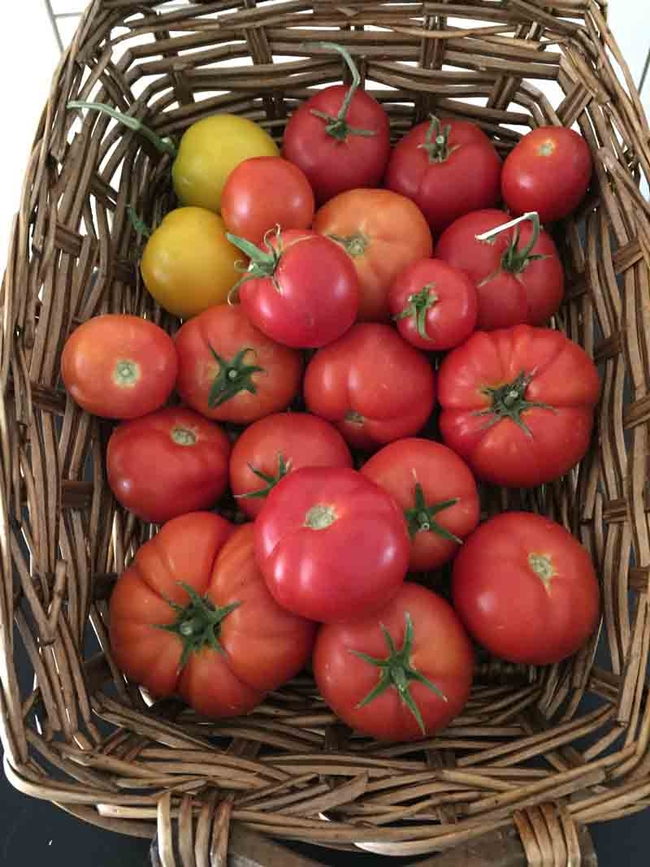
If your tomato plant has good green leaf color, is flowering and has fruit developing, but its leaves are curling up, you are experiencing a common summer problem for tomatoes in our area. The culprit again is most likely heat. Tomato leaves transpire water from the undersides of their leaves. When a tomato plant can't take in as much water as it is losing, its leaves will curl up. This occurs when the soil is too dry, the temperature is too hot, or it's too windy. Check soil moisture by poking a finger an inch into the soil. If it's dry, it's time to water. Leaf curl is the tomato's way of reducing leaf surface area to reduce water loss. Curling up will not affect fruit production or the health of the plant.
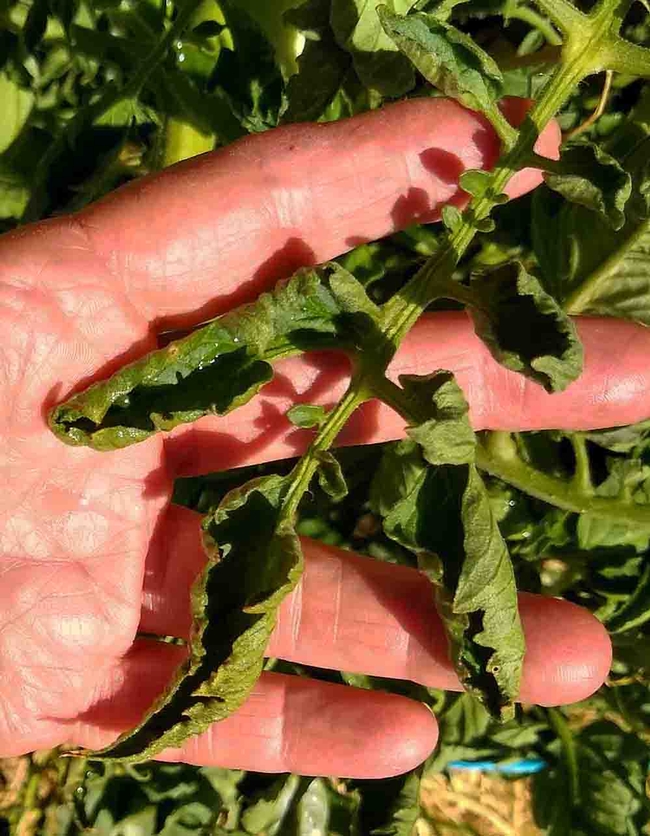
There is one further thing to rule out before you rest in the tranquility that upward leaf curl requires no action on the gardener's part: pests. Check a few leaves to be sure the curl isn't harboring an insect or caterpillar cocoon. No caterpillar, no problem. Your tomatoes are fine in their self-protective upward curl.
A two- to three-inch layer of mulch around tomatoes will help the soil retain moisture and stay cooler. Straw, wood chips, chopped leaves, and grass clippings are all fine mulches for this purpose. Mulch also helps keep moisture around tomato plants more even; this can keep the fruit from cracking and help to prevent blossom drop.
Ever wondered how to encourage sweeter tomatoes? Here temperature and sun are your friends, to a point. Ninety degrees and lots of sun will give you a sweeter tomato. At 100 degrees, fruits develop color on the outside, but stay green on the inside: not tasty. So when temperatures soar, pick tomatoes that have begun to color and allow them to ripen indoors. Remember: never refrigerate a tomato.
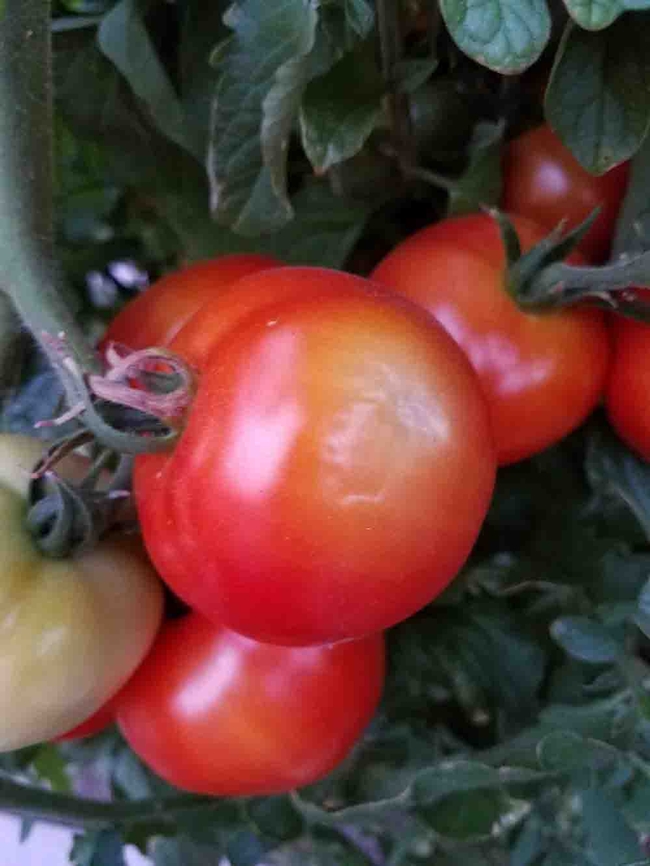
UC Master Gardeners of Butte County are part of the University of California Cooperative Extension (UCCE) system. To learn more about us and our upcoming events, and for help with gardening in our area visit our website. If you have a gardening question or problem, email the Hotline at mgbutte@ucanr.edu or leave a phone message on our Hotline at 530-552-5812. To speak to a Master Gardener about a gardening issue, or to drop by the MG office during Hotline hours, see the most current information on our Ask Us section of our website.

- Author: National Pesticide Information Center (NPIC)
Acetic acid, also known as vinegar, is used in products for weed control. Many people choose it because it is natural. However, acetic acid can damage skin and eyes, especially at concentrations commonly found in weed killers.
What is the difference between acetic acid, vinegar, and horticultural vinegar?
You may know acetic acid best as vinegar. Vinegar is a solution of acetic acid in water. Acetic acid is a naturally occurring substance that is found in all living things. It is formed during fermentation. Acetic acid can also be made industrially. It is used in many industrial processes, including the manufacture of dyes, plastics, some drugs, and other industrial chemicals. It is also used in textile printing.
Household vinegar such as distilled white vinegar used for cleaning or cooking generally contains 4-6% acetic acid, which is diluted in water. Higher strength acetic acid solutions are sold for other purposes. Horticultural vinegar typically refers to a concentrated solution of 20% or more acetic acid. It is sold to kill weeds. You may find even higher concentrations of acetic acid sold in stores or online.
Are there health risks of using vinegar/acetic acid?
Acetic acid is irritating to the eyes and skin. At concentrations above those usually found in household vinegar, it can be extremely irritating or corrosive. Acetic acid can permanently damage the corneas if it gets into your eyes. It can burn skin and the tissues of your mouth and throat if you accidentally swallow it. People have had irritation in their nose, throat, and in their lungs if they breathed in enough of the vapor.
Never leave any pesticide unattended around children or pets. Never leave any pesticide in an unlabeled container. "Natural" does not mean "safe!" Remember, the dose makes the poison. The higher the concentration of acetic acid, the greater the risk.
How does vinegar/acetic acid kill weeds?
Acetic acid is a non-selective contact herbicide. It must touch the foliage of the plant in order to work. It does not damage tissue it does not touch. It does not travel throughout the plant. Acetic acid breaks open cell walls and causes cell death. The plants die by drying out.
Acetic acid breaks down rapidly in the environment. It does not leave a residue.
Acetic acid readily turns into a vapor. Like other chemicals, warmer temperatures increase volatilization, or turning into a vapor. The vapor can irritate the nose, throat, and lungs if breathed in. Prolonged exposure to high concentrations of the vapor can cause fluid buildup in the lungs.
What sort of pesticide/herbicide products contain vinegar/acetic acid?
Products containing vinegar/acetic acid that have been registered by the United States Environmental Protection Agency (U.S. EPA) as pesticides/herbicides will have a signal word and an EPA registration number on their packaging. Label information includes where and how to use the product, what precautions to take, personal protective gear to wear while using the product, and first aid instructions in case something goes wrong.
Products registered to be used as herbicides have high concentrations of acetic acid, typically 20% or more. All registered herbicides containing acetic acid have a signal word of DANGER because of the high concentrations and high toxicity. Specifically, it is because of the risks of the acid to the eyes and skin. Low concentrations of acetic acid are used in insect lures.
Acetic acid is available commercially for many purposes. Consider purchasing a product registered as a pesticide if you plan to use acetic acid for weed control. Doing so means you will have directions for use as an herbicide and information on precautions you can take to keep risks low. Products that do not have an EPA registration number and signal word are not registered to be used as herbicides and may not have appropriate safety or precautionary information for that use. Look for an EPA Registration Number and a signal word to ensure you are purchasing a registered product.
How can I reduce the risks when using vinegar/acetic acid?
- Any time you use a pesticide, always read and follow all label instructions. The label is the law.
- If the label specifies personal protective equipment, you must use that equipment.
- Wear long sleeves, long pants, shoes, socks, and gloves at a minimum whenever using any pesticide.
- Consider wearing protective eye wear and chemical resistant gloves when mixing, diluting, or applying vinegar as an herbicide because of its acidic and corrosive nature. The label instructions may require their use.
- Keep everyone else away from the treatment area until dry.
- Keep all pesticides away from children and pets. Remember that horticultural vinegar can badly damage your eyes or blind you!
- Consider integrated pest management strategies that do not use chemicals to control weeds.
For more information about pesticides and pesticide safety, visit the National Pesticide Information Center (NPIC) website at npic.orst.edu.
[Originally featured in the Summer 2024 edition of the Home and Garden Pest Newsletter]


